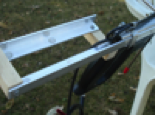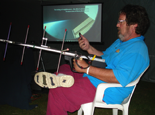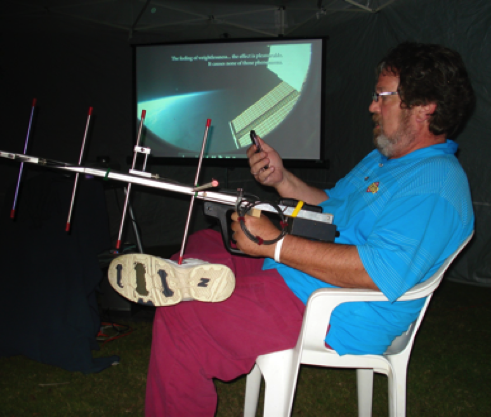A little disclaimer up front. There are many antennas, radios, satellite tracking programs, et al out there that are being used to successfully work the FM ham satellites. What I offer on my sites are items that I have purchased, have personal experience using, and know are currently supported. For example, I have heard of a satellite tracking software program that is working great for some ... but it has no support from the author, and it hasn’t been updated in more than 17 years. I see no need to frustrate my visitors with unsupported software or products as they start out. Also - remember where I am coming from: keeping it simple, using equipment many hams already own. “Simple” to me means being able to walk outside with an antenna in one hand and a HT in the other - and successfully work a FM satellite or two.
OK - with that out of the way, let’s talk about radios.
RADIOS
It is preferable to work the FM sats in full-duplex mode (where you can hear the downlink as you key your mic). But only one recently manufactured HT did that well in V/U and U/V modes: the Kenwood TH-D72a (discontinued 4Q 2020). Neither the Alinco DJ-G7T nor any of the recent crop of “dual-receive” imported radios work well in both V/U and U/V modes for FM voice satellite work. The Powerwerx Wouxun UV-9D Plus works on AO-9 full-duplex ... but you will have to use dual rigs for SO-50. That Kenwood TH-D72a was unique!
If you desire to work true, full-duplex, you can use a second radio in your setup. Or a scanner for RX. Working in full-duplex mode can really make the difference: it lets you know if you're making it, and that you are not accidentally “stepping” on other operators.
You’ll sometimes see me using a Kenwood TH-F6a with its all-mode receiver to monitor SSB birds. Or my Yaesu FT-817ND.
But for hundreds of contacts and scores of demos and presentations in front of live audiences the past few years, I have been using the Yaesu FT-60R successfully. It is not a full-duplex HT. BUT you can program “split frequencies” in one memory in many Yaesu HTs: You can program 440 receive and 2M transmit in a single memory location (or vice versa). Programming charts for the FM sats are on my Home Page.
I own too many HTs. (There ... I said it. First step in the “HT addiction” recovery process ... ) Many retail for more than the FT-60R. But the FT-60R is a GREAT value for anyone looking for a solid 2M/440 handheld. The FT-60R debuted at Dayton in 2004. It was a great bargain then - and remains so today. Among its features ...
● 1,000 memories
● receives (essentially) 108mHz to a gig (including AM aircraft)
● large, legible display
● easy to manually program (one-page cheat sheet here)
● bulletproof case design***
● strongest belt clip of any ham HT chassis on the market
● great receive audio
... as well as a unique battery setup: You can use the optional FBA-25 AA case with either NiMH cells or alkalines, and have full TX power available (if you really need it).
Side note on batteries: I have been using Maha’s 2700mAH NiMH AA cells in a pair of FBA-25 cases - with one of Maha’s intelligent AA cell chargers. A great combination. Properly maintained, I should achieve from 500-1000 complete discharge-charge cycles from them. I am amused at the proclamation by Panasonic that their eneloop AA NiMH cells can be charged “up to 2100” times - which is contrary to most scientific literature regarding the capabilities of consumer-grade NiMH cells. (A little discrepancy between the scientific community and marketing people, I guess ... )
There are some long-discontinued full-duplex HTs that many are using for the satellites, like (not an all-inclusive list) the Icom IC-W2a and the earlier serial-numbered IC-W32a, Kenwood TH-D7 and TH-D79, and Yaesu’s FT-470/FT-51/FT-530 models. There are others ... but I’d hate to see you spend a bunch of money on really old units with no warranties ... fewer repair options ... and decreasing availability of battery packs!
ANTENNAS
Let’s start with the most popular “ultimate” in portable FM satellite antennas: the Elk Log Periodic Model 2M/440L5 and the Arrow Antenna Model 146/437-10WBP. Either cost approximatelty $120-160.
There was plenty of “Elk vs. Arrow” debate on the ‘Net a while back. Most of it pure rubbish - and not written by people who have actually knew and used both units as they made their uneducated allegations. A couple of the re-occurring “anti-Arrow” themes ...
“Arrow doesn’t publish gain numbers for their antennas.”
This is true. Maybe because people mis-use such numbers. But reliable test data is out there - and thousands of owners will attest that their Arrow Antennas are performing magnificently for what they were designed to do.
“The Arrow is hard to transport.”
Well, I used to devote my entire Ford Ranger’s covered pickup bed to my Arrow when I took it places. Rarely has it been disassembled. But to make it absolutely flat, all one needs to do is unscrew the three 2M element pairs, and you have a flat plane of an antenna. Nowadays, either of these two great antennas fit in the back of my Ford Edge.
“Arrows are all engineered wrong - they cannot possibly work.”
A little story for you. While working for HRO-Anaheim a few years ago, I sold an Arrow to a customer for working the satellites. I had first-hand experiences with the Arrow product line, and therefore could wholeheartedly recommend Arrow to others. The gentleman was waiting for me to open up the shop the next morning, with his Arrow in hand.
“I know antenna theory, and this antenna cannot possibly work - it is engineered all wrong - I want a refund!” - he demanded.
Hmmm. Part of me wanted to discover if he assembled it correctly, and whether or not he actually tested it. But the other part of me was thinking, “Well, I can purchase it myself as an open-box item ... ”
Which I did. And it is the SAME antenna that I used for more than a decade at demos and presentations. I have replaced some elements - cosmetically, they fade in color (NOT hindering performance).
Moral of the story: The Arrow Antenna may not please some engineers. But it sure pleases those who desire to work the FM satellites.
“The Arrow Antenna is much heavier ... " -
I have brand-new, un-opened Elk and brand-new, un-opened Arrow in my hands. The Elk package weighs 35.6 ounces. The Arrow weight 33.6 ounces. Any “weight difference issue” is, well, NOT an issue.
And on and on ... EITHER antenna is a great investment. Most of the anti-Arrow nonsense on the ‘Net reminds me of while my wife was proudly carrying her Nikon F in the 1970s (arguably the most significant SLR body in 35mm history), others would comment, “Oh, my Pentax / Minolta / Canon is as good as that ... “ --- But you never heard any Nikon owner state any such comparison ... (grin).
How does the performance of the Elk and Arrow compare? Both work the FM satellites birds very well. Either makes working the FM sats feel like “cheating” - the gain is that dramatic over any HT whip improvements you might make.
But from someone who has purchased both and has used them both, the Arrow “senses” the initial capturing of a satellite’s signal more definitively than the Elk does. (And that is mostly due to the Elk’s design and its wider frequency range.) I mean, in front of darned near every audience, I’ll declare, “There it is!” - when those close to me don’t hear anything of note. But that slight “dip” in the background noise ... you can just hear the beginning of capturing the signal slightly better with the Arrow than with the Elk. This is NOT a scientific conclusion - just my personal observation after working the sats for several years with both antennas, and, again, an inherent phenomenon of the wider-range receive capability of a log periodic.
But how about spending about $130 LESS than the cost of an Elk or Arrow to get into the world of high gain? Build yourself a tape measure beam (plans on the ANTENNAS page). I built one following those plans to the letter - and have worked the FM sats with it - as well as the ISS! Do they really have any gain? YES! Connected one to my FT-60R, and I heard the San Diego NOAA WX frequency for the first time ever with a handheld radio from my house in Jurupa Valley. These are fun to build ... fun to show to non-ham friends ... and always a conversation-starter!
And although it takes more patience and finesse to work with “lesser” antennas, remember this: One of the first 2M reception reports from the 250mW transmitter aboard the then-new ARISSat-1 satellite was from a gentleman using a STOCK DUCK on his Yaesu VX-8 HT! And a ham friend in Vancouver is working the "easy" FM voice sats with his HT and just a modest antenna improvement. SO ... simple HT antenna improvements (Smiley 270A ... Diamond SHR-320A) are certainly viable options - at least for 2M reception!
SMA ANTENNA ADAPTERS
Protect your HT’s antenna jack - ESPECIALLY if it is an SMA connector. SMA connectors are rated at fewer connects/disconnects than BNC, and are generally more “delicate” than their BNC counterparts.
If you are planning to use your SMA-receptacle radio with differing antennas, please consider protecting it with a BNC-to-SMA adapter. One adapter does NOT fit all HTs: There are differences in the dimension of ham HT antenna receptacles and their relationships to their cases. Use our message board or email link to find one right for YOU. Hey - it is up to you: Wear out or damage your HT’s SMA connector - and face a $65 repair job. OR wear out a $15 adapter connector ... (grin)
There are also quality 18” jumpers available (Comet ... BNC-Female, PL, N) that take the stress off your HT’s antenna receptacle.
SPEAKER-MIC
Some FT-60R owners have experienced - usually when using aftermarket audio accessories - the plug can be partially yanked out without realizing it - causing accidental transmissions.
It seems that some aftermarket audio accessories’ 3.5mm 4-conductor plugs’ TIPS still are not quite shaped the way Yaesu’s receptacle would like. (I know: I was sales manager for Pryme/Premier for a couple years, and experienced this problem as we “corrected” it with our overseas manufacturers for Yaesu owners.)
I have yet to have this phenomenon occur with my Yaesu MH-34B4B or SSM-17A speaker mics. Small in size ... nice texture to the plastic case ... and a 1/8” (3.5mm) jack in the bottom for an earpiece (or, in my case, I will sometimes run an audio cord to the MFJ external audio amplifier described below). BUT - in any case, you can prevent the "yanking out" phenomenon from happening by simply using one of those “charity bracelets” (see the ARROW MOD photos above).
I have also been known to use my Heil single-sided Traveller to work the satellites. The Traveller morphed the "Heil Pro Micro Single Side.” And currently, the single-earpiece "HTHY" and dual-earpiece "HTHDY." And if you run across a new-old-stock Pryme SPM-902 speaker-mic - snag it.
AUDIO AMPLIFIER
For normal ops, the addition of received audio amplification really isn’t necessary. But Gordon West and I were demonstrating working the satellites at the Orange County Fairgrounds under really noisy conditions (right aside the Kid Zone’s ferris wheel and carousel!). We NEEDED some audio amplification for the group to hear. And the little MFJ-382 does the trick. Runs off a 9V rectangular battery ... just remember to turn it OFF when done, as it’ll drain that battery if left ON.
PROJECTOR, SCREEN (pre- and post-pandemic)
Another little story. Before I purchased my own projector, I was invited to a club in mid-2007 to give my satellite presentation. “No problems here,” I was assured. “We’re using the college's media center - we can project ANYthing you have ... “ The kiss of death, of course. Arrived, and they could not get my MacBook Pro connected and running on their “media center” equipment setup. I did the show without the presentation file. Thank goodness we had an excellent pass to work out in the parking lot ... (g)
SO - I immediately started researching projectors. Went to many sites and many reviews. For ME back in 2007, I settled on the Hitachi CP-X2 due to its image quality, 802.11 connectivity, and Mac compatibility. (This particular model is now discontinued.) It was also constructed well, and came with a three-year warranty. And just a week shy of that three-year warranty, the top control panel died. Could not turn the projector ON (unless I used the wireless remote that came with it). I called my dealer - they gave me a loaner, and Hitachi replaced the entire top switch assembly and associated power supply parts. No charge, of course.
When researching a projector purchase, I was glad I ran into Ed Goldman of Global Presenter in Huntington Beach, CA. (He’s no longer there, though.) But it was important for me to get to know someone who knew their products well, listened to my requirements, and made appropriate suggestions. Ed was great. Pricing at Global was fair. I found out that there is a “grey market” for projectors. I mean, I could have saved $100 on the projector by purchasing from a dealer NOT authorized by Hitachi to sell this unit in the U.S. - but it would have been a unit meant for out-of-U.S. sales with NO warranty valid in the U.S. Make your purchasing decision wisely.
When I told Ed I wanted a screen that would really make photographic images look great, he recommended the Da-Lite Versatol. And I carry mine in its protective soft nylon case all the time. (Well, at least before our current pandemic.) I am now using an Epson EX3280 projector: HDMI and 3600 Lumens. Do some research - I purchased this great model a few years ago ...
Kensington has been my choice for several computer-related accessories, and I mainly used their model K75233EU presentation pointer to control my presentations. Current version is their K72427AMA. I was on a beta test team for this model. Fits great in your hand. Buttons laid out well. And this particular model also has a built-in MicroSD reader and a USB memory stick that slides INSIDE the pointer.
In a perfect world, you could save your presentation onto the USB dongle, and just carry that with you into a venue and hand the dongle to the a/v person: “My presentation is on this - and this is also the receiver for my remote ... “ - and you could run your show that effortlessly. BUT - I would rather be in more control, so I use my own computer and projector ... so the on-dongle memory is my Plan B in case of catastrophic failure of my stuff. (Yes, I also always have a Plan C, too.) The Kensington unit is both Mac- and Windows-compatible.
- - - - - - - - - - - - - - - - - - - - - - - - - - - - - -
* - Apologies to the heirs of Glenn Miller.
** - Why just 2W TX power? That is sometimes all that is needed.
*** - OK, the FT-60R isn’t truly “bulletproof.” But several of my audiences have seen me toss one across the stage - literally - during my presentations to show that they stand up to a little abuse ... Do not try that at home, though.
Updated January, 2024




